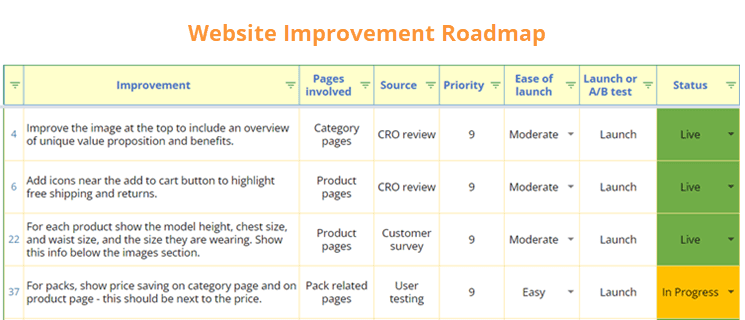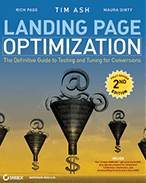The Ultimate Guide to Conversion Rate Optimization (2024)
Last updated |
It’s no longer just about driving more website traffic to to increase revenue. To really increase sales you need to optimize your website experience to convert more of your visitors. This new technique is called conversion rate optimization (CRO), and many websites already gain great results from it.
Are you ready to take advantage too?
This isn’t just a basic conversion rate optimization guide.
While it starts with the basics, this guide reveals the essential aspects of CRO, including:
- The four main elements of conversion optimization
- The importance of conversion research
- A CRO process flow to maximize your success
- How to gain more budget and buy-in for CRO
It’s a detailed guide and is therefore quite long, so here’s a table of contents:
What Is Conversion Rate Optimization (CRO)?
Conversion rate optimization is the art of converting more visitors on your website into your goals (e.g. sales or leads). By increasing your conversion rate, you’ll be able to boost your website revenue without actually needing more traffic.
What Are the Benefits of Doing CRO for Your Website?
The biggest benefit of conversion rate optimization is that it helps you generate much more revenue from your website. Here is how:
- Generates more sales on your website, with your existing traffic, which means you don’t have to spend more money driving more sales.
- Increases your average order value (AOV) so when your users purchase, they buy more products per order, or more expensive products.
- Maximizes your return on investment (ROI) from your marketing spend, and reduces the cost per acquisition.
- Improves your website so that it engages more visitors, and increases the chances of them returning and converting into paying customers in the future.
What Kind of Results Can I Expect From Doing CRO?
This depends on how much effort you put in and your level of expertise. With modest efforts you can increase your conversion rate by 5-10%.
This may not sound like much, but it often has a big impact on your revenue.
If you maximize your efforts with CRO you can get amazing results like these I got for my clients:
- 44% increase in conversion rate for UnboundMerino.com, and $216K in annualized revenue.
- 164% increase in conversion rate for ManlyBands.com, and $988K in annualized revenue.
- 19% increase in conversion rate for JosephJoseph.com, and £260K in annualized revenue.
- 66% increase in conversion rate for an online mattress retailer, and $2.6M in annualized revenue
What Are the Main Elements of CRO?
CRO is made up of four overlapping main elements – conversion research, user experience (UX), website persuasion, and A/B testing and personalization. Making strong use of these will increase your chances of gaining more conversions, and therefore boosting your sales.
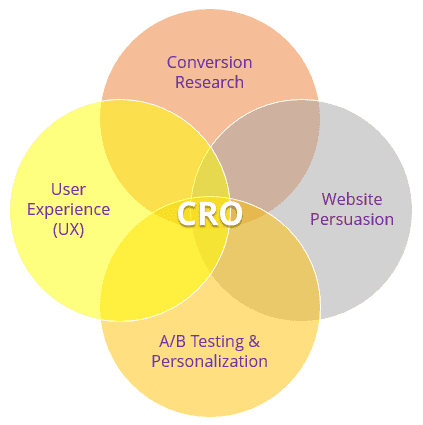
- Conversion Research: Gather insights and improvement ideas from conversion research. This comes from web analytics, heat maps, visitor recordings, surveys, user testing and expert CRO reviews. This is the most essential piece of CRO, and cannot be done effectively without it.
- Website Persuasion: Don’t just hope your website converts your visitors. To engage and convert many more of them, use copywriting best practices and influence techniques, including the usage of social proof, scarcity, urgency and reciprocity.
- User Experience (UX): Improve your website user experience so visitors can browse and convert more easily, including using best practices for improving your website navigation, forms and user flow. Without it, it doesn’t matter how well your website ranks in the search engine results page (SERP) or how persuasive it is.
- A/B Testing and Personalization: A/B tests and personalization techniques are used to discover and show the highest converting experience for your website. This is very useful, but not essential, particularly because so many websites don’t have enough traffic or conversions for this.
All of these elements overlap and feed into each other to gain better results from CRO, particularly conversion research. For example insights from conversion research feed into better ideas for A/B testing and personalization.
Why is Conversion Research So Important?
Don’t just guess at what to improve on your website, or only listen to what your boss wants to improve, as this often fails to get good results on your conversion rate and revenue.
Conversion research is essential for determining what needs improving and why from your users and customers.
There are 5 elements of conversion research that you need to use to gain the best results:
- Visitor recordings. Use these to watch exactly what visitors do on your website. They are great for discovering visitor issues, like page elements or form fields they find hard to use. Always gain insights from these recordings for pages you want to improve.
- Heat maps. These are a good compliment to visitor recordings. Don’t just presume you know what website visitors click on or how far they scroll – check these for your key pages. Great for revealing CTAs, images and content that should be clicked on more.
- Surveys. It is essential to find your visitors and customers issues, doubts, hesitations and needs with visitor surveys and customer surveys. Discovering this will help you create very high-impact website improvement ideas and boost your website optimization efforts.
- User testing. Gain feedback from your target audience while they try to complete tasks on your website and ask them questions. This is a great way to discov what your target audience think of your website, their issues with it, and what needs improving.
- Expert reviews. This is done by an experienced CRO expert (often called heuristic analysis), and is a fast effective way of getting CRO insights and recommendations. These are offered by CRO experts including myself, CXL and WiderFunnel.
Insights from these elements of conversion research then feeds into better ideas for the other elements of CRO, including A/B testing.
Avoid copying ideas from website competitors – just because they are doing something doesn’t mean it works well or will work on your website. Instead monitor what best converting websites are doing like Amazon.com and AO.com. Ideas from your HiPPO (highest paid person’s opinion) rarely work well either, unless they are an expert in CRO or web usability.
Conversion research is often neglected or not well understood, apart from web analytics, so you have huge potential to take advantage of this element of CRO in particular.
How is Website Persuasion Used in CRO?
You need to persuade your website visitors to purchase or sign up – don’t just hope they will. This is why you need to use this newer technique of website persuasion, which is one of the 4 main elements of conversion rate optimization.
Compelling copywriting plays a huge part in persuasion, particularly headlines, bullet points and CTAs. Mention how your website solves pain points and benefits. My copywriting guide gives many best practices and techniques to use.
Social proof, urgency, scarcity, reciprocity are essential influence techniques to use, as made famous by Robert Cialdini’s ‘Influence’ book.
Social proof is particularly important to show prominently, including reviews and ratings, testimonials, ‘as featured in’ and logos of well known customers. Doing this will increase the chances of visitors thinking your website is liked by others, and also using it.
Showing urgency and scarcity messages can also work well. People don’t like to feel like they may miss out, so this messaging can help convert visitors, for example showing when there is only a few products left in stock, or a countdown timer for when a sale will end.
Why is User Experience (UX) Essential For CRO?
It doesn’t matter how good your website looks or how persuasive it is, if visitors find it hard to use they will not convert very often.
Therefore you need to ensure you adopt website usability best practices to improve your website user experience. Navigation, landing page forms and user flow elements are very important elements of UX to improve, and here are some good examples:
- Use tool tips for fields or pieces of content that require explaining.
- Improve your navigation menu and internal search.
- Use good filters and sort options on category pages.
- Ensure your website looks good on different mobile device widths.
Best practice UX improvements should be just launched and don’t need A/B testing first. UX trends should be A/B tested first though.
Can You Do CRO With Low Traffic for A/B Testing?
A/B testing is certainly a part of conversion rate optimization, along with personalization, but it is not essential. While it is very useful for discovering which versions of your website ideas convert better, many websites don’t even have enough traffic to do A/B testing.
You will need at least 5,000 unique visitors per week to the page that you want to run an A/B test on, and at least 200 website conversions per week.
If you don’t have enough traffic you should just launch your website improvement ideas and then monitor their impact on your website conversion rate. Here is a great guide that explains how to do CRO if you have a low traffic website.
Do I Need to A/B Test All Improvements or Just Launch Them?
You don’t have to A/B split test every CRO improvement you want to make to your website. This would require a lot of traffic, time and effort.
However, there are improvements you can just launch, even if you have enough traffic to A/B test them. These are considered best practice and will improve any website, so should just be launched without needing A/B testing first. This frees up time to A/B test other elements with higher impact.
Launch it – website improvements to launch instead of A/B testing:
- Usability fixes and improvements (like improving confusing navigation, unfriendly checkout error messages, and font sizes that are too hard to read)
- Prominent unique value proposition elements on your key entry pages (the key reasons to purchase on your website versus competitors)
- Purchase risk reducers like guarantees, free shipping and free returns, particularly on your product pages
- Social proof on key pages like customer reviews, testimonials, media mentions, third party ratings and awards
You can certainly do follow up A/B testing to fine tune these or iterate on the exact location or style of them, but the key thing is to just launch them first because they are so important to have.
A/B test it – website elements always worth A/B testing:
Any time it’s unclear whether the improvement will actually perform better, you should A/B test it, and when you have multiple variations you think might do well, but aren’t sure which will do best. Here are some examples:
- Big ideas that change many things at once, including page redesigns
- Headlines on your homepage or key entry pages
- Copy for your product descriptions and benefits
- Influence and persuasion elements mentioning scarcity or urgency
- Ideas taken from competitor websites (they often won’t work well)
Can You Run Many A/B Tests at The Same Time?
To get better results on your conversion rate and revenue, you need to be able to A/B test frequently, ideally at least a few times per month depending on your website traffic.
A good way to increase the amount of A/B testing you can do is to launch several at the same time, but be aware of potential issues. The key thing is to make sure they don’t influence each other too much, and try to only have one A/B test running per page, or you risk the results being inaccurate or unfair. If you have a signficant amount of traffic you can run more than one per page by setting up mutually exclusive A/B tests, which involves segmenting your users into segments so that they are only part of one A/B test at time.
How to Make Best Use of Personlization for CRO
Don’t just do A/B testing, move beyond this by also doing personalization to improve your websites’ conversion rate.
Instead of a one-size-fits-all approach, you need to personalize your website to engage more visitors and boost conversions. Headlines and hero images on key entry landing pages have particularly good impact for personalizing.
One of the best ways to use personlization is to target visitor segments with more relevant content:
- Returning visitors with content relating to what they saw previously
- Frequent purchasers with loyalty content like rewards or discounts
This personalization can be done with any good A/B testing tool, like VWO or Convert.
However, it doesn’t matter how well personlized your website is if it doesn’t have a good user experience or doesn’t persuade them to convert. To see best results from personalization you need to ensure your website has first been improved with the other elements of conversion rate optimization.
What Tools Do You Need For CRO?
For doing conversion rate optimization, you need three key types of website tools:
- A web analytics tool. This is essential because it helps you monitor your current website conversion rate and success metric performance. It also helps you to gain great visitor insights and find poorly converting pages for improving. Google Analytics needs to be set up and used for this, which is free.
- Visitor and customer feedback tools. Getting great feedback from your visitors and customers is essential for understanding their needs and issues. This is because it helps you gaining high-impact ideas for improving your website and conversion rates. The most important tool to use for this are creating customer and visitor surveys using Hotjar.com. User testing tools like Userfeel.com and UsabilityHub.com are important for gaining detailed feedback too.
- An A/B testing tool. Ideally you need to test different versions of your content (like different call-to-action buttons or page layouts) to see which version increases your conversion rate and revenue the most. Read my comparison of A/B testing tools to help you understand which tool is best for your needs.
Is There a Process I Can Use to Get Better CRO Results?
Conversion rate optimization shouldn’t be done randomly or only as a once-off project -an ongoing process is needed for success. I created a CRO success flow that helps ensure you get the best results for improving your conversion rates and website sales. Here are the 5 steps of this process:
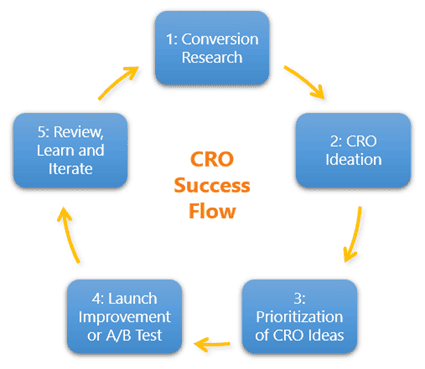
Step 1 is to do in-depth conversion research, this is essential and was discussed earlier in this guide.
Conversion research then feeds into CRO ideation step 2 where ideas are created for improving your website, along with ideas from website persuasion and UX elements (2 of the other parts of CRO).
Prioritization of CRO ideas in step 3 is important to ensure you launch ideas with highest impact.
Next in step 4 you launch the website improvement or A/B test it (if you have enough traffic).
To help you track the status of each of your improvement ideas you should also use a roadmap spreadsheet. I use these with each of my clients and it really helps to project manage your CRO efforts and ensure that all your improvement ideas get launched.
The last and very important thing to do for step 5 is to review, learn and iterate from what you have launched or tested. This then feeds back into forming more conversion research, and the process continues again.
What Website Elements Have Biggest Impact on CRO?
Unfortunately there is no silver bullet that will work every time. Depending on your type of website, your unique value proposition and your type of visitors, there are hundreds of website elements in your overall website design that contribute to increased conversion rate.
However, by improving the elements below, you’ll have a much better chance of increasing your conversion rate:
- Call-to-action buttons. These important call-to-action (CTA) buttons that influence visitors to take an action on your website have a high impact on your conversion rates. To improve their effectiveness, improve the wording, style, color, size and even the location of them on your pages. Dual CTA buttons can be used effectively when there is more than one main goal, as can adding useful related text very close to the button. Here are some good examples as inspiration:
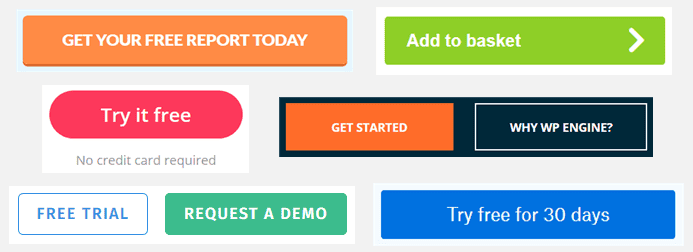
- Headlines and product page descriptions. If your text doesn’t grab the attention of your site visitors and intrigue them to read the rest, then there will a greater chance of them exiting your website, lowering your conversion rates. Test improving your headlines by keeping them simple, and using wording that solves for visitors’ needs or explains benefits. You should condense long blocks of text in product descriptions, and use bullet points instead – these are far easier for visitors to scan and understand quicker. Here is a good homepage example:

- Your home page and key entry pages. These are often referred to as your landing pages, and usually get the most traffic on your website, so they often have the biggest impact on conversion rates. Making sure these are engaging, focused, uncluttered and solve for your visitors main needs will greatly increase your conversion rate. Using targeting for your A/B tests on these pages to customize your visitors experience will meet their needs better and increase your conversion rates too.
- Shopping cart and checkout pages or signup flow pages. These are key because if your visitors struggle with these pages (regardless of how good their prior experience has been on your website), then they will abandon your website, lowering conversion and your potential revenue. In particular, you need to make your forms simple to complete. A few ideas include removing nonmandatory fields, improving your error validation, using risk-reducers like security seals, highlighting the benefits of using your website, and adding guarantees and shipping/returns offers.

- Product or service videos. You really need to create and show short videos of your products or service being used, as this helps users visualize and explain benefits and features much better than images can. You should also ensure product videos are very prominent by including them in your image gallery on product pages, and A/B testing this for my clients has gained some of my best A/B test results.
Fix Hidden Website Issues to Improve Conversion Rates
It doesn’t matter how well you improve your website if hidden issues aren’t discovered and resolved.
And I’m not talking about 404 issues or broken links — it’s the less visible things impacting user experience that you may not have checked very well or your developers may have missed.
Here are some of the other most common ecommerce hidden websites issues:
- Broken/squashed layout on smaller devices with 375 width
- Mega menus that cover important content and CTA buttons
- Cookie banners blocking your CTA buttons or live chat
- Poor or not understandable field error validation in checkout or signup
- Layout broken on tablet due to stretched buttons or images that are too large
- Product page image gallery is not working properly on mobile
- Site search is not working well or giving poor results
See more examples of hidden common website issues that you need to fix.
The best way to discover these hidden issues is by using a tool like BrowserStack.com to check your website in the most common browsers and devices, and do regular user testing with a tool like Userfeel.
Fixing these has a huge positive impact on the conversion rate and revenue for your website.
What is a Good Conversion Rate?
This is a common question, and the answer is that good conversion rates vary. This is because conversion rates are hugely dependent on your website type, your unique value proposition, and your online marketing efforts.
For a rough benchmark though, 2% is the average conversion rate for ecommerce websites and anything above 5% is considered very good. But to prove my point, it’s not unusual to have conversion rates above 50% for good, focused paid search lead generation landing pages.
Also, don’t compare your conversion rate to your competitors or what you have read in a blog post or a report – it’s risky because it may set you up for a fall or set incorrect expectations to your boss. It’s more important to increase your current conversion rate – never stop improving!
How to Gain More Budget and Buy-in for CRO
Now that Google Optimize has sunset, there are no free A/B testing tools, and you will also need budget for the tools you need for conversion research. That means you will often need to gain budget from senior stakeholders for doing conversion rate optimization.
I suggest that you try to borrow 10% of your marketing budget for a few months to prove the ROI of A/B testing. To help do that, explain to your marketing team that increasing conversion rate increases their ROAS and cost per acquisition.
You should also show your senior stakeholders the likely ROI of running more A/B tests. Do that by calculating the potential revenue impact by increasing your A/B tests launched per month. Also remind them of any good results you have gained previously, or if you have proof that your competitors are A/B testing. That should help you gain more buy-in and budget for A/B testing.
How to Launch A/B Tests With Low Developer Resources
A common challenge with doing CRO and A/B testing is not having enough resources from developer, often meaning you can’t lauch improvements or A/B tests very quickly.
The simplest thing to start with is doing more A/B testing on your copy (homepage headlines and product page descriptions work well) and imagery, as that usually doesn’t require any help from developers. You can even do that in visual editors without needing developers (but do good QA to make sure it doesn’t break anything).
You will ultimiately need to find more developers though. You can either hire and train up new resources, but its often quicker and easier to use a good A/B test development agency to help you build tests much faster and more often than your own developers can. I recommend EchoLogyx and Team Croco for this, as they both do great work at low costs. They can even help with design too if you are lacking those resources.
Resources For Deep Diving Into CRO
Now that you have read this conversion rate optimization guide, to help you learn even more about CRO, there are a number of useful resources you should check out, from great training to courses.
- CXL Institute (includes excellent online courses)
- CXL Live (the best CRO conference)
- Landing Page Optimization Workshop (highly recommended)
- Expert Ecommerce CRO Roadmap (my free CRO tool)
Read more about my CRO services, or arrange a free CRO teardown to see how I can quickly increase your website conversion rate and revenue.
